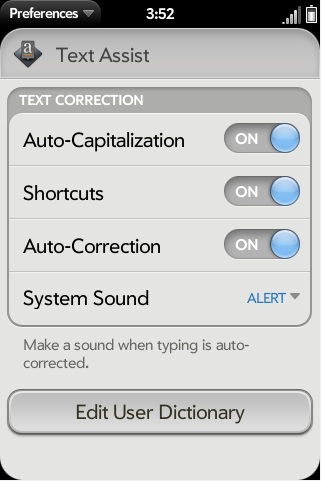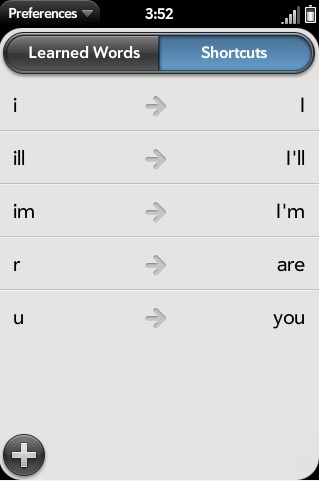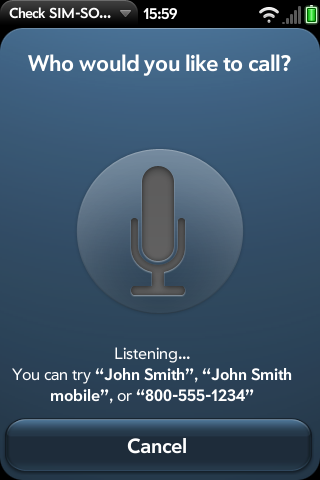webOS 2.0 Overview
by Mithun Chandrasekhar on February 3, 2011 6:05 PM ESTOther Updates
Overall, the UI has been polished up in webOS 2.0. While I cannot comment on the performance because of the non-final software I was running, the transition animations themselves appeared very smooth. HP has also updated certain HTML 5 features supported by webOS and rolled in the popular node.js Javascript framework runtime into webOS 2.0, thereby letting developers come up with their own background services in Javascript, in addition to the applications themselves. There are also a couple of other consumer-facing updates that are worth mentioning.
Although all webOS devices to date (all of two!) have had physical keyboards, spelling correction has been absent in webOS until now. Whether this is because we’ll be seeing keyboard-less webOS devices in the future or because HP thought it would be a good idea to include it anyway, we finally have a spell-check in webOS. Dubbed “Text Assist”, it performs the usual gamut of auto-corrections and lets you enter a list of user defined words.


Text Assist makes its (useful) debut on webOS 2.0
The one nice touch I most definitely appreciate here is the ability for the user to define word shortcuts. The user can now define mappings between shorthand words and how they’re supposed to be auto-corrected. “im” will become “I’m”, “were” will be set to “we’re” etc. where appropriate.
A sorely missing feature in webOS that HP has finally added is voice dial and command. By virtue of this, they have opened up developer access to the device mic. This will certainly bring in a flurry of VOIP apps, with Skype confirming that it will release a version of its app for the webOS platform (although it looks as though it will be restricted to Verizon-only devices, at least initially). This definitely fills a void in the webOS platform that has been open for far too long.



(Left)Voice dial, (Center) Favorites, (Right) dialer app now in blue
The final big update webOS 2.0 brings along with it is the inclusion of Flash 10.1 support. Yes, after multiple “It’s coming soon” promises, this iteration of webOS finally adds Flash support. Now you might be shocked to see this listed way down here, almost towards the end of the article, but there is a reason for this.
As I had mentioned earlier, we didn’t get a Pre 2 device for this article. I made use of the beta webOS 2.0 SDK and a “doctored” version of webOS 2.0 on my Pre Plus. Because of this, I could not get a true representation of the performance of the Flash implementation in webOS 2.0. This was because the SDK would be running on a full-fledged computer and the version of webOS 2.0 I had running on my Pre Plus was definitely not final.
That being said, I could see the all-important banners and short clips without much trouble. However, full-blown Flash videos were definitely choppy, with gesture controls (zoom, scroll etc.) not working. I will put this down to the beta-ness of the build and more importantly the fact that the Pre Plus only has an OMAP 3430 down-clocked to 500Mhz. Because a webOS 2.0 compatible build of Uberkernel is not around yet, I could not see if overclocking the CPU made it better in any way or form.










46 Comments
View All Comments
Chapbass - Thursday, February 3, 2011 - link
The Droid X was released in July 2010, so its 6 months old...haplo602 - Friday, February 4, 2011 - link
OLD ? I ma still using a HTC Herald with a 200Mhz CPU. The only problem I have is the small RAM (only 64MB). A larger screen and more RAM is all I need.I do not get why the phones are advancing so fast. I mean most of the time you just listen to music and browse the web. The interface is too small to do anything serious for a longer amount of time.
I guess I'll be getting a webOS 2.0 device once the new generation is out (and Outlook synchronisation works perfectly).
ant1pathy - Thursday, February 3, 2011 - link
If I could get this on, say, the Atrix, and the application library of iOS, I'd take it in a heartbeat. The software is AMAZING; too bad the hardware and mindshare doesn't reflect it.Lonyo - Thursday, February 3, 2011 - link
If they manage to make it all work nicely in a tablet format as well, then the only weak link would potentially be application support.Hopefully they will gain enough market traction to get a decent amount of apps developed, because a lot of the features sound awesome, especially JustType.
Is there any word on how much developer support there is for applications?
mythun.chandra - Thursday, February 3, 2011 - link
From the looks of it, HP is trying to get as many developers on board as it can. With webOS 2.0, they really seemed to have opened up a lot of the OS for devs to hook into directly. webOS has a pretty strong homebrew community, matching that of Android's. And from experience, developing an app for webOS is actually pretty easy (if you know basic HTML, CSS, JS..you're good to go).The issue for developers here is, no matter how good/easy webOS may be to use/develop for, it doesn't make monetary sense for them to write applications that can at best reach about 1% of the total smartphone market. What HP needs to do is move a decent amount of handsets to the market. Once this happens, developers automatically have an incentive to develop apps, with webOS' easy app dev framework only acting as a catalyst.
Jonathan Dum - Friday, February 4, 2011 - link
It's a chicken and egg problem. Developer's won't flock to HP's ecosystem until there are tons of devices, yet HP needs a strong application base until people really start buying into it. I think that's the reasoning behind Palm/HP going for the "PhoneGap" development model, but I don't think that's enough since most serious developers write an app in it's native language (Obj. C for iOS, Java for Android, etc.).mythun.chandra - Friday, February 4, 2011 - link
There does exist the PDK which lets developers develop native webOS apps in C/C++.Penti - Friday, February 4, 2011 - link
They just need to do what Microsoft and the others do, partner up with a few important developers to put out the apps that's most important. For example Dataviz canceled their development of Documents to Go, they could have put out that if Palm/HP teamed up with them. Cooperation is important, not just a ready public SDK. They could easily sign deals with developers to put out apps if they wish.Computer Bottleneck - Friday, February 4, 2011 - link
I think it would be great if HP could get some form of Web OS into prepaid.Then let the entry level consumer get used to using and learning WebOS. As time goes by let them move up the ladder to more power hardware and apps.
Hrel - Thursday, February 3, 2011 - link
This does look very usable; and straightforward. My main concern is that there isn't room for a 4 OS smartphone marketplace. I mean, average people are already confused about the difference between Android and iOS, except ones apple ones "Verizon". Yeah, I've heard that one before. "Android, that's those Droid phones on Verizon right?" Even though you can get them on any network. I haven't even mentioned Win7 yet. Now there's going to be another one? They'll need one hell of a marketing campaign to break into the minds of the sheeple.For the most part it seems like people buy what their family/friends buy. Or if they get addicted to a specific app they'll stick with it. I think Windows cloud based features will earn a lot of loyalty.
On hardware I'd still like to see a smartphone that can truly replace my point n shoot camera. I'm talking almost instant photo taking when I hit the button, no 3 second pause. with a slide out design except no keyboard, joystick/s and a couple buttons for gaming. That's what I wanna do with it, play video games, shoot photos, record video. Surf the web, get directions, check movie times, watch youtube, use it as an mp3 player.